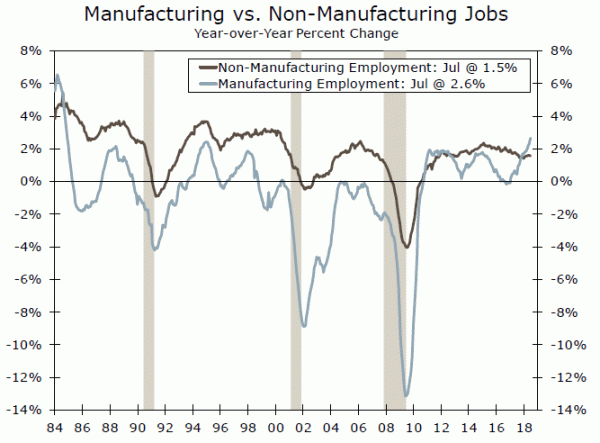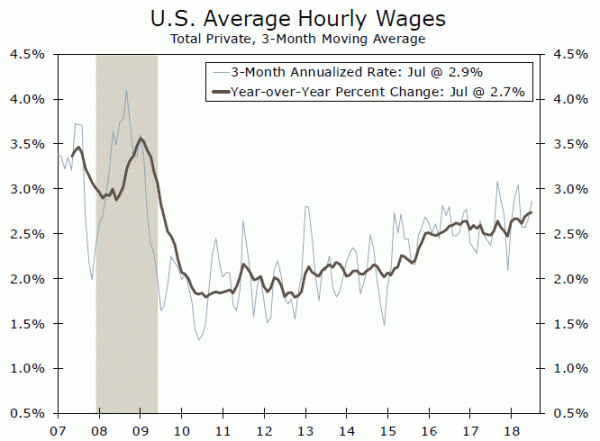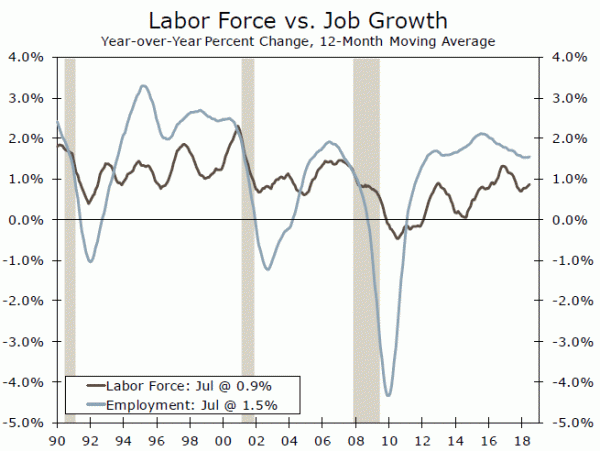Payrolls rose 157,000 in July, while gains in May and June were revised up. Along with a pickup in wages and lower unemployment, the labor market continues to strengthen and supports the Fed’s plan to hike next month.
Revisions Take the Edge Off of the Headline Miss
Employment growth slowed in July, with employers adding 157,000 new jobs. July’s gain was somewhat weaker than expected, but came on the heels of a net upward revision of 59,000 to May and June. Healthcare, leisure & hospitality and temporary employment posted notable gains. Manufacturing also stood out with 37,000 jobs added—the largest monthly increase this year. While the evolving trade picture has manufacturers concerned about costs and profits, the heady pace of hiring suggests that the sales outlook among the nation’s manufacturers has not deteriorated (top chart).
Wages Trek Higher, Consistent with Tighter Labor Market
Average hourly earnings rose 0.3 percent over the month, keeping the yearago change at 2.7 percent (middle chart). That is up from the 2.5 percent pace this time last year and, along with the stronger Employment Cost Index reading reported earlier this week, shows wage pressures have begun to intensify as the labor market has tightened.
The income proxy, which combines aggregate hours worked and average hourly earnings, is rising at a 5.1 percent three-month annualized pace and points to some strengthening in consumer spending from the pace registered over the first half of the year.
Unemployment Resumes Its Downward Trend
Even with today’s miss, the trend in payroll growth remains solid. Employers have added an average of 215,000 jobs per month since the start of the year, which is up from an average of 182,000 in 2017. That is still plenty strong enough to put further downward pressure on the unemployment rate, which fell back to 3.9 percent in July. Employment growth is running at about twice the pace of the labor supply (bottom chart).
Improved participation has helped support growth in the labor force as the working-age population has stalled out. The increasing availability of jobs and rising wages have encouraged more workers to join the labor force. A record 71 percent of labor force entrants are becoming employed within one month. The workers that have been pulled into the labor force has helped keep the labor force participation rate generally steady despite the aging of the population shaving off about a ¼ percentage point each year. Overall labor force participation was flat in July, but ticked up for prime age workers (ages 25-54). Slack continues to diminish both inside and outside the labor force, with the U-6 unemployment rate, which includes under-employed and marginally-attached workers, falling to the lowest rate since 2001.
On balance, today’s report is unlikely to change the Fed’s assessment that “the labor market has continued to strengthen,” as the overall trend in hiring remains strong, labor availability continues to decline and wages are moving higher.















